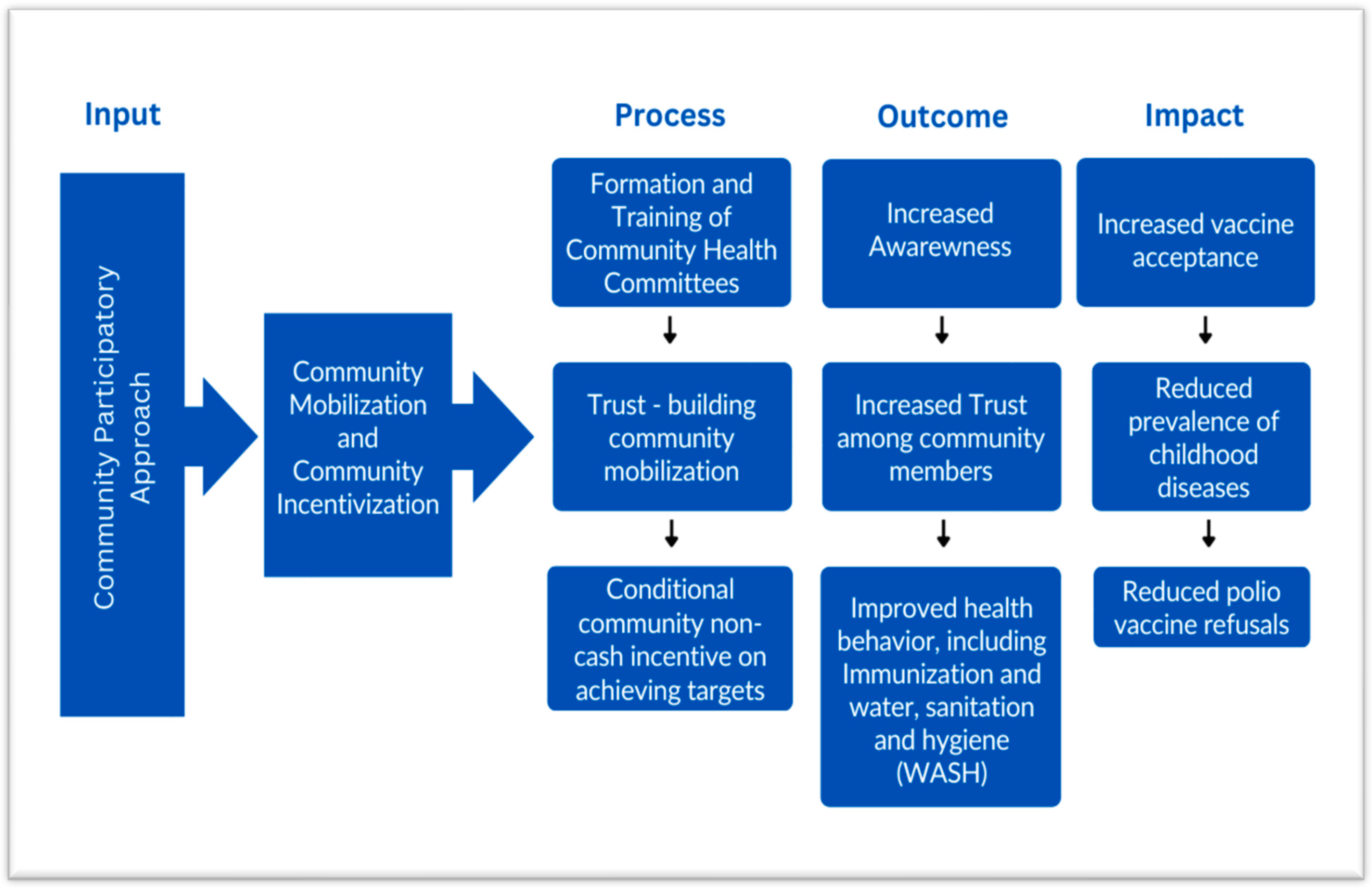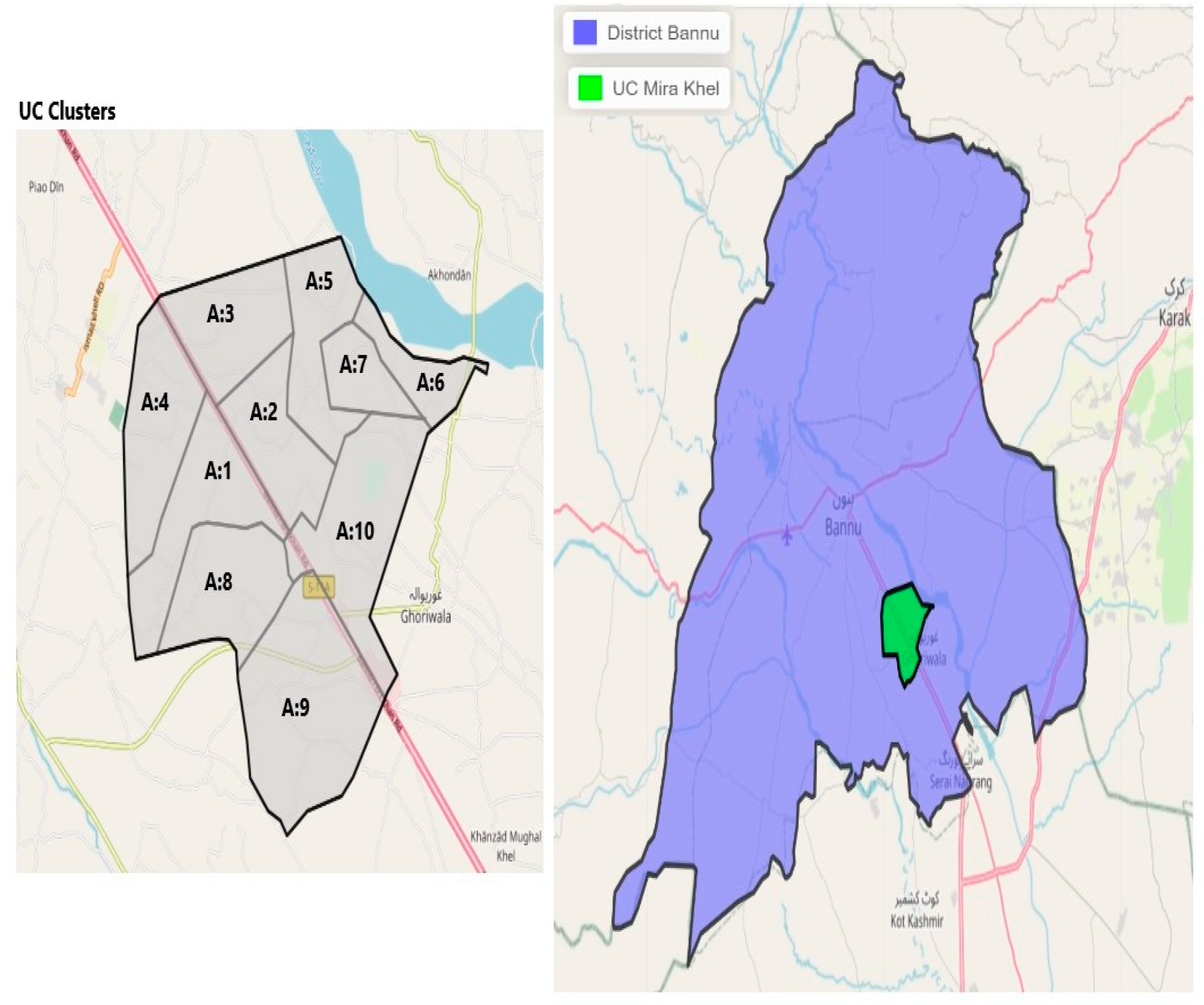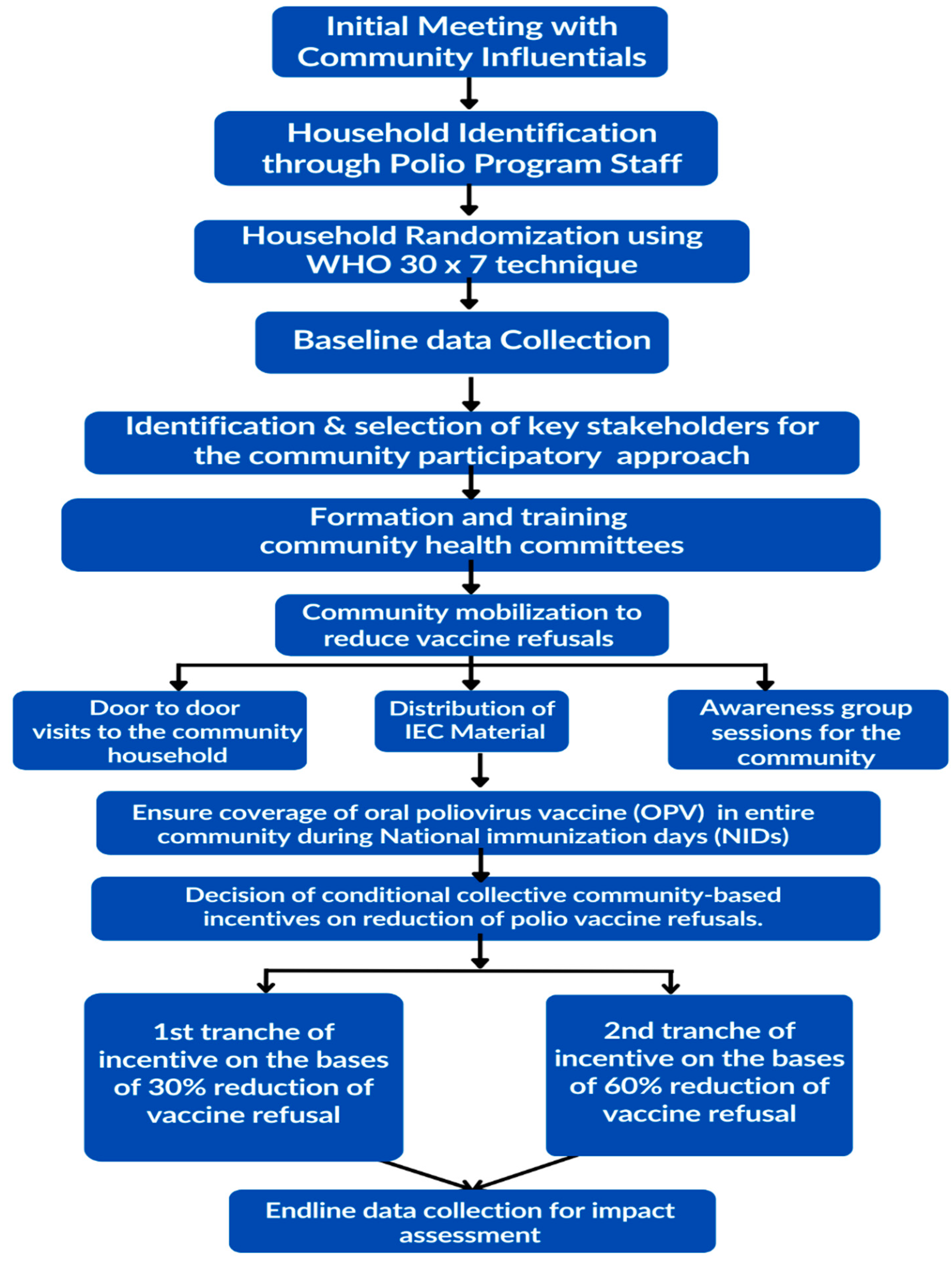The Last Mile—Community Engagement and Conditional Incentives to Accelerate Polio Eradication in Pakistan: Study Protocol for a Quasi-Experimental Trial
Abstract
:1. Introduction
2. Conceptual Framework
3. Methodology
3.1. Objective
3.2. Study Design
3.3. Intervention
3.4. Study Setting
3.5. Study Duration and Registration
3.6. Outcomes
3.7. Study Population
3.8. Sample Size and Sampling Strategy
4. Project Implementation
4.1. Planning Phase
4.2. Implementation Phase
4.2.1. Community Mobilization
4.2.2. Conditional–Collective–Community-Based Incentives (C3I)
4.3. Close-Out Phase
5. Monitoring and Evaluations
5.1. Team Composition
5.2. Data Collection
5.3. Quality Assurance
5.4. Monitoring
- Each data collector will be expected to submit/sync only completed and accurate questionnaires, and every day the supervisor will check the data for completeness and timely syncing.
- Any discrepancies or missing data found will be resolved through discussions with the interviewers, reviewing photographs of the vaccination card (if available) or revisiting the HHs if necessary. Steps to improve the next day’s work will also be deliberated upon.
- District supervisors will conduct a validation process to ensure the accuracy and completeness of the collected data. They will specifically focus on verifying the boundaries of households, clusters or segments. The purpose of this validation is to ensure that field workers do not inadvertently or deliberately omit eligible households from the data collection process. By conducting this validation, the district supervisors aim to maintain the quality and integrity of the data.
- A dedicated quality control associate at the data management unit (DMU) will also review pictures of immunization cards which will be taken by survey teams and compare them with the results of the survey to validate the quality of data transcription by data collectors.
- The CHCs’ performance and refusal rates will be assessed via independent and robust monitoring through independent surveys, data from the National Emergency Operations Centre (NEOC) and Polio Eradication Program data for OPV coverage.
- To improve the acceptance of the vaccine along with staff performance, stakeholders’ engagement, the performance of community groups, community mobilization sessions and the frequency of individual and group meetings will be monitored.
- Conditional non-cash need-based incentives will be decided based on reductions in the polio vaccine refusals, PMC and SMC.
6. Statistical Analysis
7. Discussion
Author Contributions
Funding
Institutional Review Board Statement
Informed Consent Statement
Data Availability Statement
Acknowledgments
Conflicts of Interest
References
- Benefits from Immunization during the Vaccines for Children Program Era—United States, 1994–2013; Centers of Disesaes Control and Prevention: Atlanta, GA, USA, 2014.
- Pan American Health Organization (PAHO). Available online: https://www.paho.org/en/topics/immunization (accessed on 15 January 2023).
- Bugvi, A.S.; Rahat, R.; Zakar, R.; Zakar, M.Z.; Fischer, F.; Nasrullah, M.; Manawar, R. Factors associated with non-utilization of child immunization in Pakistan: Evidence from the Demographic and Health Survey 2006-07. BMC Public Health 2014, 14, 232. [Google Scholar] [CrossRef] [PubMed]
- Habib, M.A.; Soofi, S.B.; Ali, N.; Hussain, I.; Tabassum, F.; Suhag, Z.; Anwar, S.; Ahmed, I.; Bhutta, Z.A. Knowledge and perceptions of polio and polio immunization in polio high-risk areas of Pakistan. J. Public Health Policy 2017, 38, 16–36. [Google Scholar] [CrossRef] [PubMed]
- Armah, G.; Pringle, K.; Enweronu-Laryea, C.C.; Ansong, D.; Mwenda, J.M.; Diamenu, S.K.; Narh, C.; Lartey, B.; Binka, F.; Grytdal, S. Impact and effectiveness of monovalent rotavirus vaccine against severe rotavirus diarrhea in Ghana. Clin. Infect. Dis. 2016, 62 (Suppl. S2), S200–S207. [Google Scholar] [CrossRef]
- World Health Organization. Immunization Coverage. Available online: https://www.who.int/news-room/fact-sheets/detail/immunization-coverage (accessed on 16 December 2022).
- National Institute of Population Studies (NIPS) [Pakistan] and ICF International. Pakistan Demographic and Health Survey 2012-13; NIPS and ICF International: Islamabad, Pakistan; Calverton, MD, USA, 2013. [Google Scholar]
- Program Ppe. WPV Polio Cases across Pakistan’s Provinces. Available online: https://www.endpolio.com.pk/polioin-pakistan/polio-cases-in-provinces (accessed on 11 January 2023).
- Abid, N.; Islam, O.; Bosan, A.; Darwish, A.; Bile, K. Pakistan’s fight against poliomyelitis: Introducing innovative strategies to address challenges and attain the goal of eradication. EMHJ-East. Mediterr. Health J. 2010, 2010 (Suppl. S16), 5–14. [Google Scholar] [CrossRef]
- Tabassum, F.; Nazia, T.; Nooruddin, S.; Hussain, I.; Umer, M.; Feroz, K.; Aarif, S.; Soofi, S.; Habib, A. Journey to vaccination using a heuristic approach in Pakistan: A qualitative study. Int. J. Community Med. Public Health 2022, 9, 667. [Google Scholar] [CrossRef]
- Larson, H.J.; Cooper, L.Z.; Eskola, J.; Katz, S.L.; Ratzan, S. Addressing the vaccine confidence gap. Lancet 2011, 378, 526–535. [Google Scholar] [CrossRef] [PubMed]
- Larson, H.J.; Jarrett, C.; Eckersberger, E.; Smith, D.M.; Paterson, P. Understanding vaccine hesitancy around vaccines and vaccination from a global perspective: A systematic review of published literature, 2007–2012. Vaccine 2014, 32, 2150–2159. [Google Scholar] [CrossRef] [PubMed]
- Jheeta, M.; Newell, J. Childhood vaccination in Africa and Asia: The effects of parents’ knowledge and attitudes. Bull. World Health Organ. 2008, 86, 419-A. [Google Scholar] [CrossRef] [PubMed]
- Polio Endgame Strategy 2019–2023: Eradication, Integration, Certification and Containment; 2019 (WHO/Polio/19.04); Licence: CC BY-NC-SA 3.0 IGO; Geneva; World Health Organization: Geneva, Switzerland, 2019.
- Hystad, P.; Carpiano, R.M. Sense of community-belonging and health-behaviour change in Canada. J. Epidemiol. Community Health 2012, 66, 277–283. [Google Scholar] [CrossRef] [PubMed]
- Suarez-Balcazar, Y.; Francisco, V.T.; James, L.A. Behavioral Community Approaches. In Introduction to Psychology: Becoming a Change Agent (Chapter 16); Jason, L.A., Glansman, O., O’Brien, J.F., Ramian, K.N., Eds.; College of Science and Health Full Text Publications. 1; Available online: https://via.library.depaul.edu/cshtextbooks/1 (accessed on 1 August 2023).
- Luder, H.; Frede, S.; Kirby, J.; King, K.; Heaton, P. Health beliefs describing patients enrolling in community pharmacy disease management programs. J. Pharm. Pract. 2016, 29, 374–381. [Google Scholar] [CrossRef] [PubMed]
- Meillier, L.K.; Lund, A.B.; Kok, G. Cues to action in the process of chaning lifestyle. Patient Educ. Couns. 1997, 30, 37–51. [Google Scholar] [CrossRef] [PubMed]
- Williams, D.M.; Rhodes, R.E.; Conner, M.T. Conceptualizing and intervening on affective determinants of health behaviour. Psychol. Health 2019, 34, 1267–1281. [Google Scholar] [CrossRef] [PubMed]
- Schneider, E.C.; Shah, A.; Doty, M.M.; Tikkanen, R.; Fields, K.; Williams, R.; II, M.M. Reflecting Poorly: Health Care in the US Compared to Other High-Income Countries. New York: The Commonwealth Fund. 4 August 2021. Available online: https://search.issuelab.org/resources/38740/38740.pdf (accessed on 22 February 2023).
- Das, J.K.; Salam, R.A.; Rizvi, A.; Soofi, S.B.; Bhutta, Z.A. Community Mobilization and Community Incentivization (CoMIC) Strategy for Child Health in a Rural Setting of Pakistan: Study Protocol for a Randomized Controlled Trial. Methods Protoc. 2023, 6, 30. [Google Scholar] [CrossRef] [PubMed]
- Wikipedia. Available online: https://en.wikipedia.org/wiki/Karachi_Central_District (accessed on 17 December 2022).
- Wikipedia. Available online: https://en.wikipedia.org/wiki/Bannu_District (accessed on 15 February 2023).
- ClinicalTrials.gov. Available online: https://clinicaltrials.gov/ct2/show/NCT05721274?term=Community+Engagement+and+Conditional+Incentives&draw=2&rank=1 (accessed on 13 March 2023).
- Shaikh, S.; Memon, S.; Ahmed, I.; Manzoor, R.; Shaikh, S. Impact of an IEC (Information, Education and Communication) intervention on key family practices of mothers related to child health in Jamshoro, Sindh. Pak. J. Med. Sci. 2014, 30, 611. [Google Scholar] [CrossRef] [PubMed]
- Jarrett, C.; Wilson, R.; O’Leary, M.; Eckersberger, E.; Larson, H.J. Strategies for addressing vaccine hesitancy—A systematic review. Vaccine 2015, 33, 4180–4190. [Google Scholar] [CrossRef] [PubMed]
- Tabassum, F.; Nooruddin, S.; Habib, A.; Ali, N.; Hussain, I.; Pach, A.; Memon, Z.; Soofi, S.; Bhutta, Z.A. Programmatic evaluation of a school-based typhoid vaccination campaign: Findings of qualitative research. Int. J. Community Med. Public Health 2021, 8, 4273. [Google Scholar] [CrossRef]
- Immunization Coverage Cluster Survey: Reference Manual; World Health Organization: Geneva, Switzerland, 2005.
- StataCorp. Stata Statistical Software: Release 17; StataCorp LLC: College Station, TX, USA, 2021. [Google Scholar]




Disclaimer/Publisher’s Note: The statements, opinions and data contained in all publications are solely those of the individual author(s) and contributor(s) and not of MDPI and/or the editor(s). MDPI and/or the editor(s) disclaim responsibility for any injury to people or property resulting from any ideas, methods, instructions or products referred to in the content. |
© 2023 by the authors. Licensee MDPI, Basel, Switzerland. This article is an open access article distributed under the terms and conditions of the Creative Commons Attribution (CC BY) license (https://creativecommons.org/licenses/by/4.0/).
Share and Cite
Das, J.K.; Khan, A.; Tabassum, F.; Padhani, Z.A.; Habib, A.; Mirani, M.; Rahman, A.R.; Khan, Z.A.; Rizvi, A.; Ahmed, I.; et al. The Last Mile—Community Engagement and Conditional Incentives to Accelerate Polio Eradication in Pakistan: Study Protocol for a Quasi-Experimental Trial. Methods Protoc. 2023, 6, 83. https://doi.org/10.3390/mps6050083
Das JK, Khan A, Tabassum F, Padhani ZA, Habib A, Mirani M, Rahman AR, Khan ZA, Rizvi A, Ahmed I, et al. The Last Mile—Community Engagement and Conditional Incentives to Accelerate Polio Eradication in Pakistan: Study Protocol for a Quasi-Experimental Trial. Methods and Protocols. 2023; 6(5):83. https://doi.org/10.3390/mps6050083
Chicago/Turabian StyleDas, Jai K., Amira Khan, Farhana Tabassum, Zahra Ali Padhani, Atif Habib, Mushtaq Mirani, Abdu R. Rahman, Zahid Ali Khan, Arjumand Rizvi, Imran Ahmed, and et al. 2023. "The Last Mile—Community Engagement and Conditional Incentives to Accelerate Polio Eradication in Pakistan: Study Protocol for a Quasi-Experimental Trial" Methods and Protocols 6, no. 5: 83. https://doi.org/10.3390/mps6050083
APA StyleDas, J. K., Khan, A., Tabassum, F., Padhani, Z. A., Habib, A., Mirani, M., Rahman, A. R., Khan, Z. A., Rizvi, A., Ahmed, I., & Bhutta, Z. (2023). The Last Mile—Community Engagement and Conditional Incentives to Accelerate Polio Eradication in Pakistan: Study Protocol for a Quasi-Experimental Trial. Methods and Protocols, 6(5), 83. https://doi.org/10.3390/mps6050083






